
El Shaddai
Tayana Vancouver 42 Sailboat
15 August 2010 | Merida
15 August 2010 | Jaji
15 August 2010 | Jaji, Venezuela
15 August 2010 | Venezuela
15 August 2010 | Merida, Venezuela
15 August 2010 | Merida, Venezuela
15 August 2010 | Venezuela
12 July 2010 | Puerto La Cruz, Venezuela
12 July 2010 | Puerto La Cruz, Venezuela
12 July 2010 | Tortuga, Venezuela
12 July 2010 | Tortuga, Venezuela
12 July 2010 | Tortuga, Venezuela
12 July 2010 | Tortuga, Venezuela
12 July 2010 | Tortuga, Venezuela
12 July 2010 | Tortuga, Venezuela
07 July 2010 | Navimca, Venezuela
07 July 2010 | Venezuela
07 July 2010 | Cumana, Venezuela
07 July 2010 | Cumana, Venezuela
07 July 2010 | Makro Store, Cumana, Venezuela
More Beauty
29 April 2008 | Eastern Trinidad
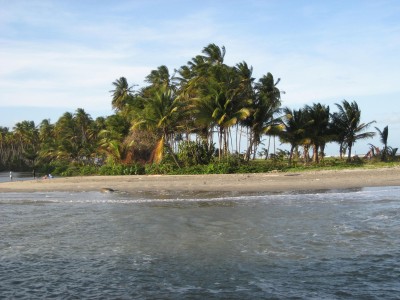
Despite the fact that we were in the process of changing a flat tire, Evelina and I wandered about and enjoyed more of the beauty Trinidad had to offer.
Breakdown
29 April 2008 | Eastern Trinidad
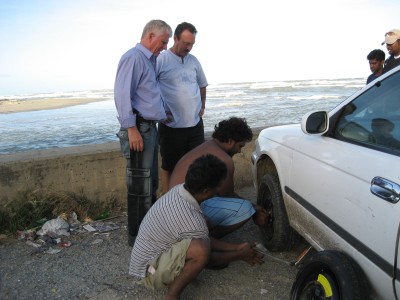
Despite the beauty of the eastern part of Trinidad, many of the roads leave much to be desired making driving very difficult. Serge skillfully managed the car through the network of roads plagued by many large potholes. One of them caused a flat tire and two locals volunteered to change it. We really appreciated their help.
Before we left they gave us a can of air as we weren't likely to find a tire repair shop as it was late in the day and had to travel to the complete other side of the island. We ended up using the can of air as the spare didn't stand up too well. When we were close to home we located a 24-hour tire repair shop.
Before we left they gave us a can of air as we weren't likely to find a tire repair shop as it was late in the day and had to travel to the complete other side of the island. We ended up using the can of air as the spare didn't stand up too well. When we were close to home we located a 24-hour tire repair shop.
More Beauty
29 April 2008 | Eastern Trinidad
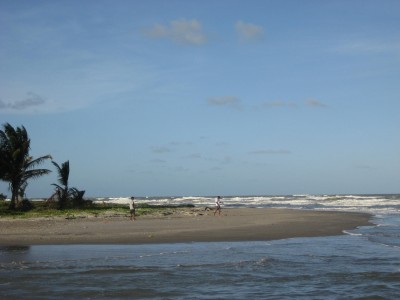
We had a wonderful time exploring the rest of the island by car. Many of the areas we saw aren't easily reached by public transportation so not well known.
Miles of Beach
29 April 2008 | Eastern Trinidad
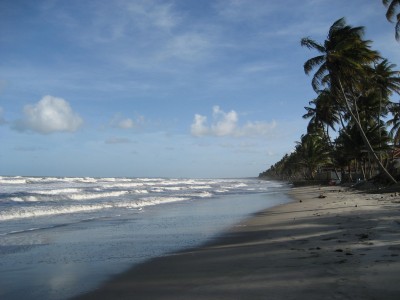
Eastern Trinidad is not heavily populated but it is spectacularly beautiful. We drove by miles and miles of uninhabited white sandy beaches with the Atlantic surf breaking over the beach. It probably wasn't too safe for swimming but sure is breathtaking.
Cristophene Closeup
29 April 2008 | Trinidad
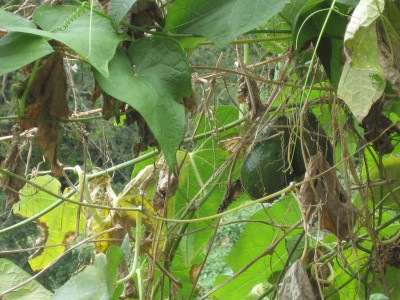
This is a popular vegetable in Trinidad and readily accessible.
Cristophene
29 April 2008 | Trinidad
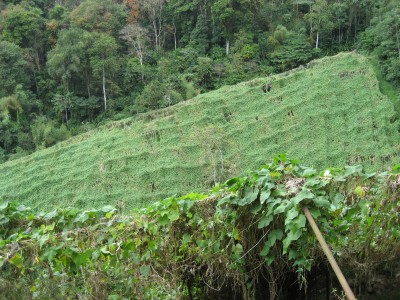
Christophene is a vegetable that can be added to stews or stuffed and baked. By itself it is quite bland but, like zuchinni, there are many creative ways you can include it in your diet.
It requires a specific altitude and climate to grow.
It requires a specific altitude and climate to grow.
Exploring
29 April 2008 | Eastern Trinidad

We found eastern Trinidad a lot slower paced than Chagaramus where the boat is anchored. It was beautiful and relaxed. These people were enjoying a Saturday afternoon cooling off in the river.
For those of you who are still wondering if there is another snowstorm on the horizon when the daffodils should be blooming, we highly recommend tropical living. It's marvelous.
For those of you who are still wondering if there is another snowstorm on the horizon when the daffodils should be blooming, we highly recommend tropical living. It's marvelous.
Exploring
29 April 2008 | Eastern Trinidad
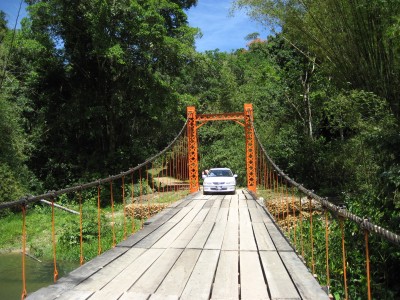
Our friends took us in a rental car to the eastern side of Trinidad that we hadn't seen before. We crossed this bridge only to find a jungle trail, not passable by cars. We weren't even sure about the security of the bridge as it was cable suspended and the boards were loose. Locals watched with interest as the car passed over the bridge.
Beauty
27 April 2008 | Maracas Bay, Trinidad
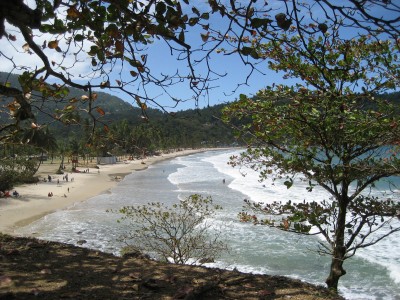
We joined our French friends one day when they rented a car and explored other parts of the island. Although we had been to Maracas Bay before we didn't see if from this vista. It is a popular beach but accessible only by vehicle or boat.
Gravesite
27 April 2008 | Chacachacare, Trinidad
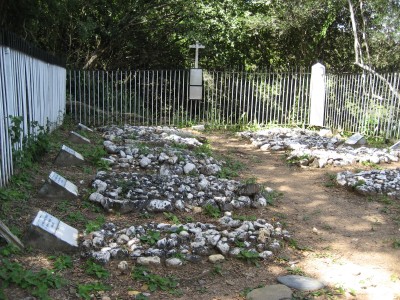
The graveyard on the island was for nuns, mostly from France. The nuns cared for the people in the leper colony before the cause of leprosy was fully understood. They probably believed they were putting themselves at great risk for acquiring the disease themselves.
Tamarind Tree
27 April 2008 | Chacachacare, Trinidad
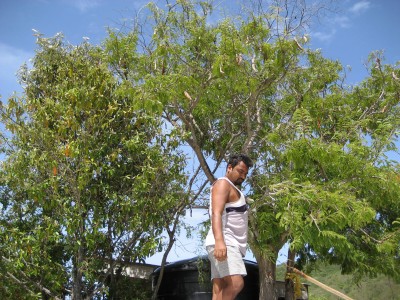
The lighthouse keepers are the only inhabitants on the island. They enjoy the fruit from the trees that were planted on the island when it was a leper colony. This lighthouse keeper is harvesting some tamarind he uses as a spice for seasoning fish. It is a long brownish pod that looks like an oversized pea or bean pod.
New Friends
27 April 2008 | Chacachacare, Trinidad
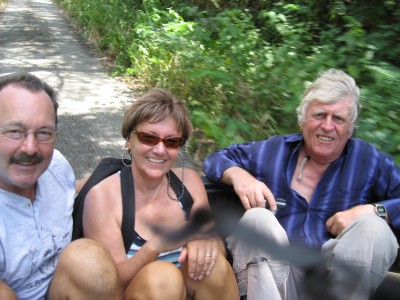
The cruising lifestyle opens opportunities to meet new people from distant lands. Our friends are from France on a catamaran called Sierra Echo.
We rode in the back of a pickup truck down from the lighthouse.
We rode in the back of a pickup truck down from the lighthouse.
Leaf Ant Colony
27 April 2008 | Chacachacare, Trinidad
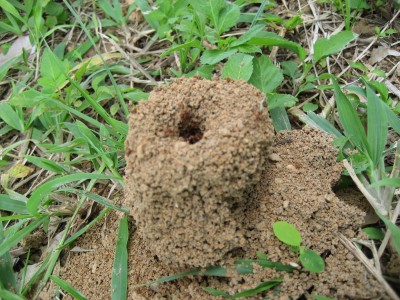
The leaf ants carry huge leaves on their back to the nest. They don't eat the leaves but instead remove a fungus that is growing on the leaf once inside their nest. Each leaf is examined by a guard for its quality and acceptability.
Palmerama
27 April 2008 | Chacachacare, Trinidad
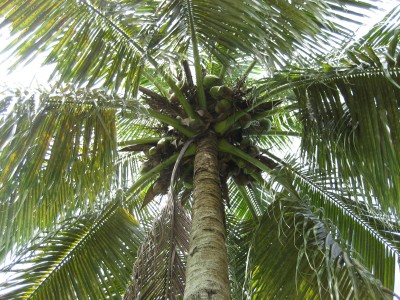
We love the tropical countries with their beautiful palm trees.
Native Attack
27 April 2008 | Chacachacare, Trinidad
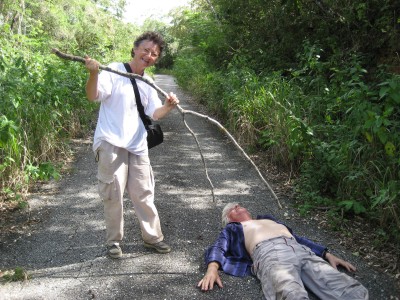
Angry natives didn't want us climbing their sacred mountain.
Our friends on this trip are Serge and Evelina, from France. They loved to clown around and have fun.
Our friends on this trip are Serge and Evelina, from France. They loved to clown around and have fun.
Cotton Bush
27 April 2008 | Chacachacare, Trinidad

On our second trip to Chacachacare (the Leper Island) we saw a lot of cotton bushes on the way to the lighthouse. The island used to be called Cotton Island before it was used as a leper colony. The cotton bushes have a sharp-edged husk from which the cotton ball is attached. Picking cotton would be a painful experience without proper picking equipment.
Woodford Square
10 March 2008 | Trinidad

Port of Spain has some lovely parks in the center of town.
Stunning Viewpoint
10 March 2008 | Maracas Bay, Trinidad

Maracas Bay is located on the north coast of Trinidad and is a spectacular drive with beautiful vistas along the way. We hired a Maxi Taxi (the common method of travel in Trinidad) to take 10 of us to Maracas Bay for an afternoon on the beach. It is about 1 hour from TTSA and not easily accessible by local taxis. The driver picked us up at TTSA, stopped at the lookouts along the way, waited while we swam and froliched at the beach for 2 hours and then returned us to TTSA. The cost per person for the day was $6. What a treat.
Unique Treats
10 March 2008 | Trinidad
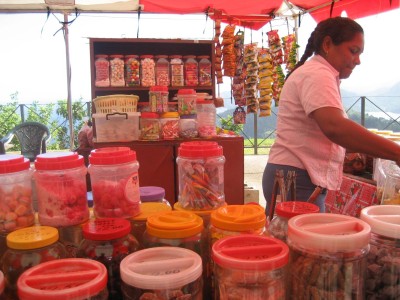
On the way to Maracas Bay is a stop where delicious and unique treats are for sale. They included East Indian dehydrated fruit and vegetables, as well as sweets.
Former Leper Colony on Chacachacare Island
07 March 2008 | Trinidad
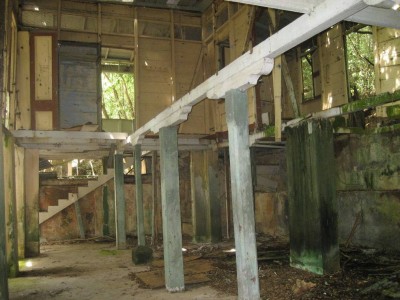
Sadly, the buildings are falling apart but are still interesting to explore.
We have really enjoyed our time in Trinidad and exploring the surrounding islands. Our computer crashed when we had a power surge which was the reason for the long time updating the blog. Hopefully we can get caught up and stay on top of it.
We have really enjoyed our time in Trinidad and exploring the surrounding islands. Our computer crashed when we had a power surge which was the reason for the long time updating the blog. Hopefully we can get caught up and stay on top of it.
Jungle Flora and Fauna
07 March 2008 | Trinidad
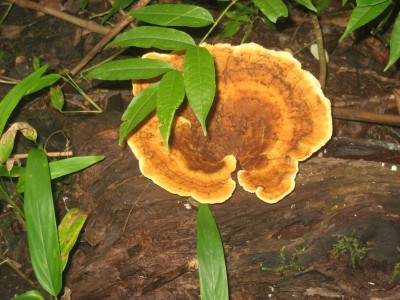
This looks like a wild mushroom but we weren't about to try them. They were located along the trail we were hiking in Scotland Bay.
Termite Nest
07 March 2008 | Leper Island, Trinidad
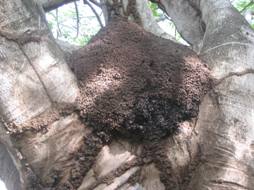
Termites are in abundance in the jungle. They build dozens and dozens of tunnels from the main nest so they can travel all day without being exposed to light as they cannot survive in the light.
Scotland Bay
07 March 2008 | Trinidad
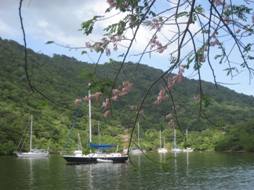
We have spent a few weekends enjoying the peace and quiet in Scotland Bay with a few other cruisers. One of the unique features about Scotland Bay is the howler monkeys howl in the morning and late afternoon and sound like roaring lions. It's hard to spot them in the jungle but their roar is unmistakable. We've been on some interesting and challenging hikes in Scotland Bay and have difficulty leaving it when our time is up.
Nuns' Residence
07 March 2008 | Leper Island, Trinidad
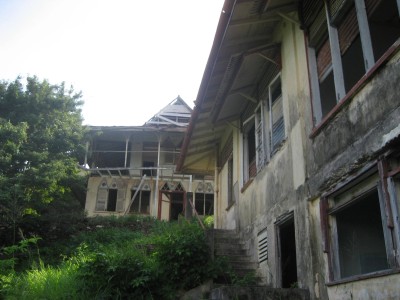
There must have been a large number of nuns working with the lepers considering the size of the residences. There is also a well-preserved grave site. The gravestones indicate most of the nuns were from France and a number of them died between 1927 and 1934 at varying ages.
History of Chacachacare Island
07 March 2008 | Trinidad

This is a beautiful island with a difficult history. It was fascinating touring it.
If Trees Could Talk?
07 March 2008 | Leper Island, Trinidad
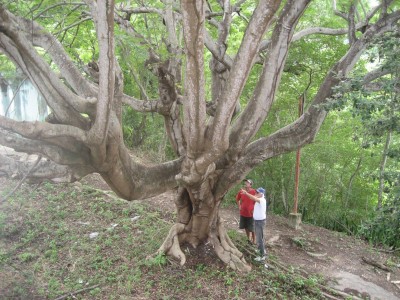
This gigantic tree shows Bill & Richard dwarfed beside it. It is situated near the nuns' residences. We marveled at the sacrifices the nuns made to care for lepers as they wouldn't have known how the disease was transmitted and were prepared to risk their own lives to care for the lepers.
Doctor's House on Leper Island
07 March 2008 | Trinidad
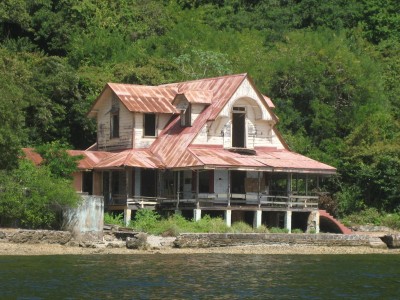
This is the doctor house. It was located quite some distance from the residences of the men and women. The island is so overgrown that you can see houses tucked in the trees but almost inaccessible without a machete to chop your way through the jungle.
Hospital on Leper Island
07 March 2008 | Trinidad
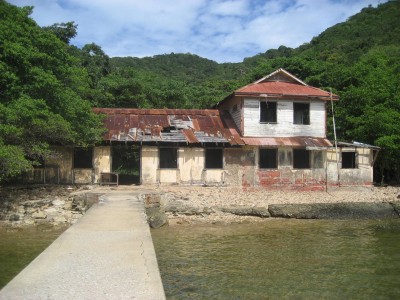
This was the hospital on the island. There was evidence on the second floor that it was used as an operating theatre. We had to be very careful walking around the buildings as they were decaying and not particularly safe.
Chiropractic Adjustment
07 March 2008 | Trinidad
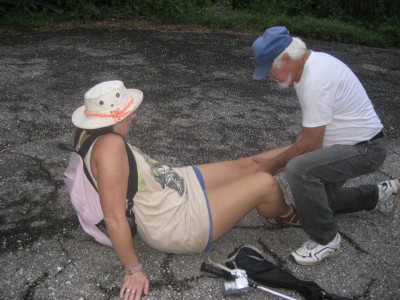
We hiked up to the lighthouse with our good friends, Richard and Shellee. On the way down Shellee's knees were causing her discomfort so she called on Richard for an adjustment (a common occurrence we were told). She stretched out on the road and Richard manipulated her knees on the spot. When she got up she felt great and had no problem for the rest of the hike.
View from the Lighthouse
07 March 2008 | Trinidad

We enjoyed the expansive view from the lighthouse. These islands belong to Trinidad although Venezuela didn't give them up easily. At a time not that long ago in geological history, the two countries were connected by land.
Hiking to the Lighthouse
07 March 2008 | Trinidad
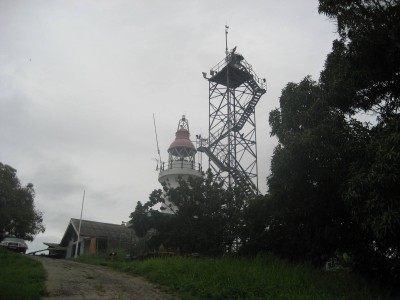
There is a manned lighthouse whose light guided us to Trinidad from Grenada. We hiked up the long road to the top where we talked with the lighthouse keeper. Venezuela is visible from the top as it is only about 6 kms. away. There is a radar station that keeps track of boats coming and going from Trinidad. It has been very effective in reducing the drug trade from Venezuela.
Cotton on Chacachacare
07 March 2008 | Trinidad
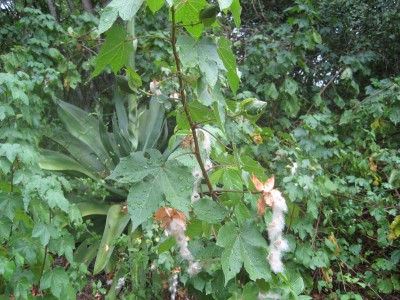
Before the island was named Leper Island, it was called Cotton Island. There are many wild cotton plants still producing cotton on the island.
Chacachacare - Leper Island
07 March 2008 | Trinidad
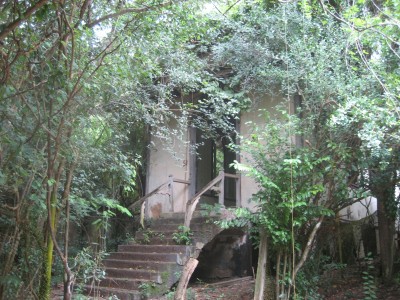
The buildings are all in varying stages of decay.
Chacachacare - Leper Island
07 March 2008 | Trinidad

Chacachacare (I love saying that name) is an island about one hour by boat from our anchorage in Trinidad. It used to be a large leper colony until the 1980's. When a cure for leprosy was found the inhabitants were moved to Port of Spain (Trinidad's capital). They left all their possessions behind. We spent over 5 nights at the island and explored many of the derelict buildings. It gave us an eerie feeling as we considered what life might have been like.
Leaf Ant Colony
07 March 2008 | Trinidad

The leaf ants are constantly busy carrying oversized leaves to their colony where they are screened for their fungus content before being admitted to the colony.
Silver Bullet
07 March 2008 | Trinidad
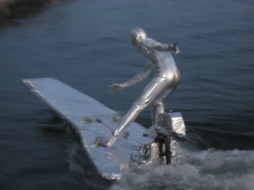
The silver bullet cruises through the anchorage on a regular basis.
Magnificent Seven
19 November 2007 | Port of Spain, Trinidad
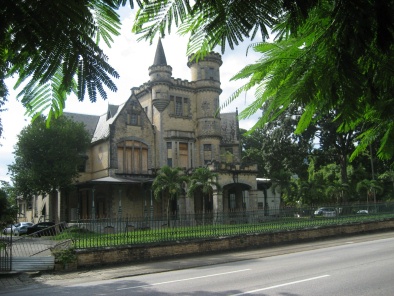
This stop in Trinidad has brought a number of major changes. First of all the compressor on our refrigerator died. We decided it would be a good time to change our refrigeration to 12 v. from 120 v. which meant trading one compressor that served the 120 v. for two for the 12 v. Budget Marine had one in stock but the other had to come from Florida. We have been keeping our limited supply of food cold by buying bags of ice daily. Meanwhile, as the compressor was failing the generator was overpowering to try and meet the refrigerator's demands and seized the regulator. We bought the generator in Dominica only 3 months previous and expected it to trip itself first. Not so. That meant transporting the 100 lb. generator to the Yamaha dealer in Port of Spain who determined it was unfixable. Only after Bill's patient explanation did they agree to check the regulator. This meant two more trips to Port of Spain sorting out things they needed and didn't have in stock. When it was repaired we hired a car and driver from town to transport us back to TTSA with the generator. To add insult to injury, one of our batteries showed signs of draining the battery. We bought two new gel batteries when we bought the boat and had one older battery on board that we believed to be the culprit. A defective battery can ruin good batteries so we have ordered another battery from Florida. Anticipated time of arrival is Dec. 7. After that we plan to head to Tobago where we expect to spend Christmas. We did request a quote on a stainless steel arch with dinghy davits but have put that on the back burner for now.
Unloved
19 November 2007 | TTSA
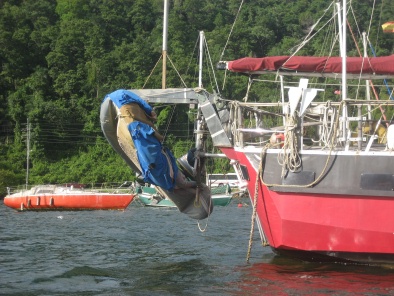
Here is another boat that has been neglected. Seeing the dinghy barely hanging off the back with the motor still attached should be an invitation to thieves. However, they seem to prefer those that are currently in service. Just over a week ago some thieves swam out from shore during the night to a catamaran anchored nearby, cut the dinghy from the boat and swam back to shore with it. Once on shore they used a hacksaw to cut the motor off the dinghy. The owners retrieved their motorless dinghy from shore in the morning. It was an 8 HP with the boat name scratched in two places. They suspect the thieves may junk it once they discover how all its markings. The cruisers left a day or so later for the Rio Macarao with only a dinghy they said could not be rowed. How discouraging. As a deterrent, we sprayed fluorescent orange paint on our Yamaha motor and put some paint on our dinghy as well. We hope thieves can see this in the dark. We also use a heavy chain and tie it to the boat. Unfortunately we do not have dinghy davits which would help even more.
This photo was used by Adventure Publications in one of their books called "Six Knots for Everyday Life".
This photo was used by Adventure Publications in one of their books called "Six Knots for Everyday Life".
Pelicans, Pelicans
19 November 2007 | TTSA, Trinidad

It was a bit rough when I took this photo of the pelicans on this boat. They seem to know where to spend time where they won't be disturbed. We watch the many pelicans with great interest as they dive for their food. They make quite a splash.
Maritime Museum
19 November 2007 | Chagaramas
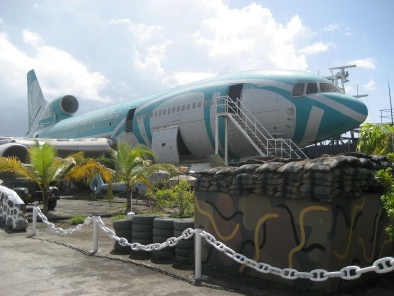
We visited the Maritime Museum within walking distance of TTSA and found it fascinating. There is a bunker inside that gives you a sense of being in the middle of the action with all the sound effects piped in. Unless somebody told us how excellent it was we likely would have never ventured in.
Divali Outside Decorations
19 November 2007 | Felicity, Trinidad
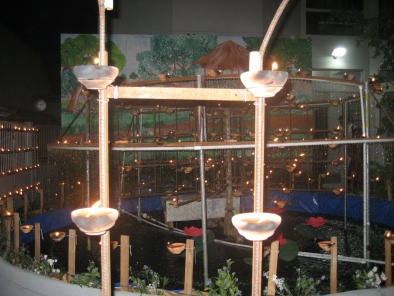
Eventually we had walked most of the streets once or twice and were getting weary. We returned to the temple and found the first bus starting to gather its load. Our party of 8 completed the load and we set off back to Chagaramus. The traffic was very heavy and the return home was slow. However, I sat next to a boater I'd never met and who hailed from Toronto so we struck up a conversation that lasted most of the journey. Others manage to doze off after a very energizing evening.
Divali Traffic
19 November 2007 | Felicity, Trinidad

Cars were bumper to bumper along the road taking in the sights, while the locals, many dressed in beautiful colored saris (women) and males in traditional dress, sat outside enjoying the masses of people looking at their lights and displays.
Divali Cuties
19 November 2007 | Felicity, Trinidad
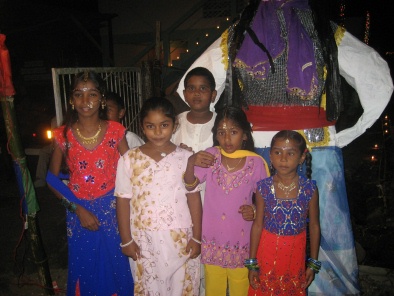
Along the way we visited another Hindu temple where we were invited to climb a spiral staircase to the roof to see the view of the city with lights. It was pretty awesome. Later that night we passed by the same temple where a few locals were dancing (more like swaying) to traditional music.
Divali Outside Decorations
19 November 2007 | Felicity, Trinidad
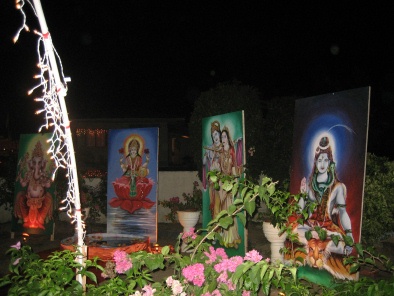
We actually had time to wander around the town before and after dinner as everyone could not be seated at once. Before dinner we watched as the locals were spreading out their earthenware pots in preparation for lighting them as soon as darkness fell. Many homes had dozens and dozens of little clay pots, and some over 100, that were carefully placed at about 3' intervals on driveways, along walkways, on walls or on long strips of bamboo in front of their homes.
Occasionally a woman from one of the homes would come out with an armful of goodies (mostly little baggies with a similar dessert as we'd been served with the meal). They offer them as gifts to passersby. We were told to accept the gifts without reciprocation. Before the night was over we had several bags of goodies clutched in our hands.
One of the boaters asked about the significance of the lady with the elephant nose and was told that Hindus consider that the most important "god" and the one they pray to first.
Occasionally a woman from one of the homes would come out with an armful of goodies (mostly little baggies with a similar dessert as we'd been served with the meal). They offer them as gifts to passersby. We were told to accept the gifts without reciprocation. Before the night was over we had several bags of goodies clutched in our hands.
One of the boaters asked about the significance of the lady with the elephant nose and was told that Hindus consider that the most important "god" and the one they pray to first.
Divali Feast
19 November 2007 | Felicity, Trinidad
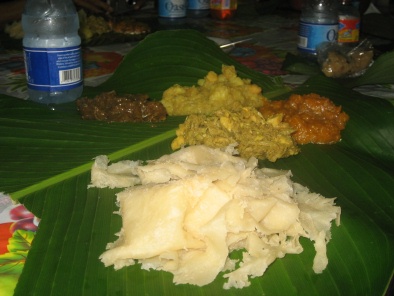
I'm not too sure what all the vegetarian meal consisted of but know there was pumpkin, curried vegetables (mango and potato), and a flat roti pastry to pick up the other food, all served on a gigantic banana leaf. There were some spicy sauces as accompaniments. For dessert there was sweet dough mixed with fruit and raisins. We were invited to eat as much as we wanted but I found this leaf full more than adequate. It was all very delicious.
Divali Outside Decorations
19 November 2007 | Felicity, Trinidad
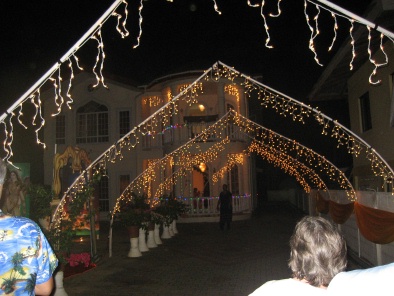
We actually had time to wander around the town before and after dinner as everyone could not be seated at once. Before dinner we watched as the locals were spreading out their earthenware pots in preparation for lighting them as soon as darkness fell. Many homes had dozens and dozens of little clay pots, and some over 100, that were carefully placed at about 3' intervals on driveways, along walkways, on walls or on long strips of bamboo in front of their homes.
Divali
19 November 2007 | Felicity, Trinidad
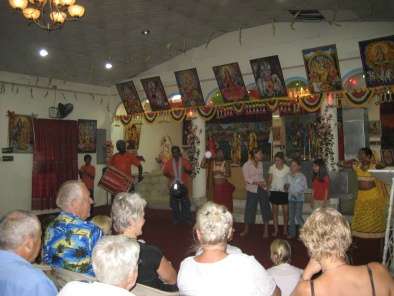
Some of the boaters' kids were invited to participate with the dancers in learning a few moves of the traditional dance. They were great sports in front of the adult audience and seemed to really enjoy themselves. We are constantly amazed at how well adjusted boaters' kids are. What a privilege for them to be part of a cruising family.
Divali
19 November 2007 | Felicity, Trinidad
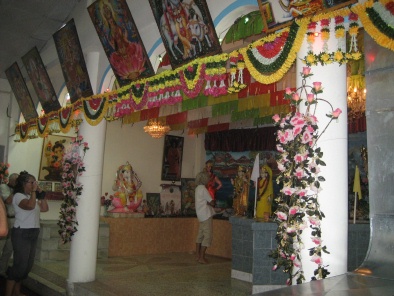
More views inside the Hindu temple.
Divali
19 November 2007 | Felicity, Trinidad
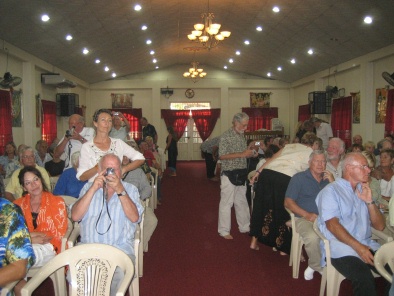
One hundred and twenty boaters showed up for this special event.
Divali
19 November 2007 | Felicity, Trinidad
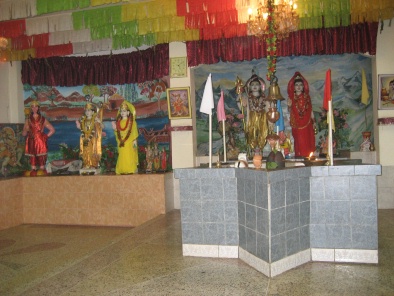
This is inside the Hindu temple where we enjoyed traditional entertainment arranged specifically for the boaters.
Divali
19 November 2007 | Felicity, Trinidad

A convoy of eight buses traveled from Chagaramus to Felicity packed with boaters (120 in all). It took close to an hour to get there. We removed our shoes before entering the temple and had a seat. We were free to take photos inside the temple. Next to being in India, it was a very interesting and unique experience.
Divali
19 November 2007 | Felicity, Trinidad
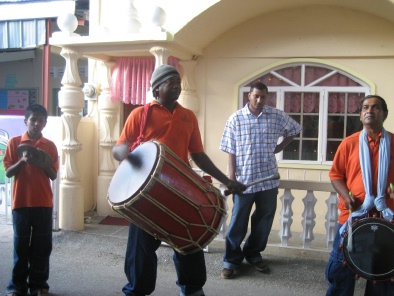
Divali is a Hindu religious festival of lights celebrated on the darkest day of the year (in October or December). We understand Divali is just as significant to Hindus as Christmas is to us. Jesse James (Members Only Maxi Taxi Service) organized a trip to a small town in the center of the island called Felicity, to visit a Hindu temple, enjoy a program of traditional music and dance, and an authentic meal. The homes are beautifully decorated with lights as well as earthenware pots with burning oil that were placed all around their properties.
Hash House Harriers
19 November 2007 | Macaripe Bay, Trinidad
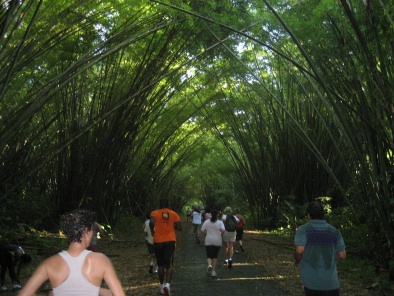
On a Saturday, seven of us went from TTSA, caught a maxi taxi and traveled to the other side of the island to a place called Macaripe Bay. We had hiked there before but this was the starting location for the hash. We watched as car after car after car rolled up and people began to gather. I'd estimate about 100 people got ready to participate in the hash. Some of the participants wore shirts bearing names of different countries where they had run a previous hash, including Nicaragua.
So, what's a hash you say? Well before the event starts one or two hashers, called the hare(s), lay a trail, in this case it was using shredded paper. The trail winds through the jungle, over logs, across streams, ditches, paths, etc. At a given signal, the rest of the hash (the Harriers, Harriettes, hounds, or pack) set off in pursuit of the trail. The idea is to keep the pack somewhat together and this is achieved by setting false trails, cunning checks, and sneaky loops. The fitter front runners will often run twice as far as the more "slothful" members, yet still finish the run at the same time as the rest of the pack. The race is typically between 4 - 8 kilometers. If you go down a false trail you end up turning around and coming back to where the false trail started, thereby traveling a lot farther than necessary. People yell "on-on-on" when they seem to be on a good trail or "on-on-back" when they discover a false trail.
At the end of the run they gather to drink beer in a Circle (which sometimes includes eating). The Circle consists of awarding "down-downs" for misdemeanors real, imagined or blatantly made up. As a visitor (or first time hasher) you are considered a Virgin, and subject to drinking a glass of beer and then pouring what you haven't consumed over your head. It's all in fun and just a big joke. So we went prepared for whatever might happen that day.
We were absolutely wiped by the end of the walk/run as we spent a lot of time running, trying to keep up with anybody in front of us so we wouldn't lose the trail. Of course, the last part of the race was up a steep hill, across the crest of the mountain, and down the other steep side. All ages participated, including kids as young as 7 or 8. DARN... at the end of the hash (Bill & I were the last of our original group of 7) they had found a ride back to TTSA so we had to miss the "down-down" section of the hash. We climbed into the back of somebody's pickup truck and he carried us right to the marina. We rushed back to our boat, finished getting our pot luck potato salad ready for the weekly Saturday night pot luck at TTSA, had a quick shower and back for more socializing with the TTSA group. What a day. I announced that if we did another hash we could not be considered "virgins" nor subject to the after party antics. However, it was made absolutely clear that until you have participated in a "down-down" you are still a virgin. So much for my theory.
So, what's a hash you say? Well before the event starts one or two hashers, called the hare(s), lay a trail, in this case it was using shredded paper. The trail winds through the jungle, over logs, across streams, ditches, paths, etc. At a given signal, the rest of the hash (the Harriers, Harriettes, hounds, or pack) set off in pursuit of the trail. The idea is to keep the pack somewhat together and this is achieved by setting false trails, cunning checks, and sneaky loops. The fitter front runners will often run twice as far as the more "slothful" members, yet still finish the run at the same time as the rest of the pack. The race is typically between 4 - 8 kilometers. If you go down a false trail you end up turning around and coming back to where the false trail started, thereby traveling a lot farther than necessary. People yell "on-on-on" when they seem to be on a good trail or "on-on-back" when they discover a false trail.
At the end of the run they gather to drink beer in a Circle (which sometimes includes eating). The Circle consists of awarding "down-downs" for misdemeanors real, imagined or blatantly made up. As a visitor (or first time hasher) you are considered a Virgin, and subject to drinking a glass of beer and then pouring what you haven't consumed over your head. It's all in fun and just a big joke. So we went prepared for whatever might happen that day.
We were absolutely wiped by the end of the walk/run as we spent a lot of time running, trying to keep up with anybody in front of us so we wouldn't lose the trail. Of course, the last part of the race was up a steep hill, across the crest of the mountain, and down the other steep side. All ages participated, including kids as young as 7 or 8. DARN... at the end of the hash (Bill & I were the last of our original group of 7) they had found a ride back to TTSA so we had to miss the "down-down" section of the hash. We climbed into the back of somebody's pickup truck and he carried us right to the marina. We rushed back to our boat, finished getting our pot luck potato salad ready for the weekly Saturday night pot luck at TTSA, had a quick shower and back for more socializing with the TTSA group. What a day. I announced that if we did another hash we could not be considered "virgins" nor subject to the after party antics. However, it was made absolutely clear that until you have participated in a "down-down" you are still a virgin. So much for my theory.
Point A Pierre
15 November 2007 | Trinidad
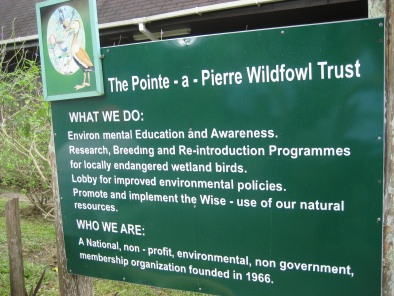
The wildlife trust is into conservation and protecting nature.
It is well worth a visit for anyone in the area.
The driver we hired from San Fernando to take us to Point A Pierre actually stayed with us and went on the tour as well. It is not the most accessible place to visit but with a little perseverance it is quite feasible.
It is well worth a visit for anyone in the area.
The driver we hired from San Fernando to take us to Point A Pierre actually stayed with us and went on the tour as well. It is not the most accessible place to visit but with a little perseverance it is quite feasible.
Ibis
15 November 2007 | Point A Pierre
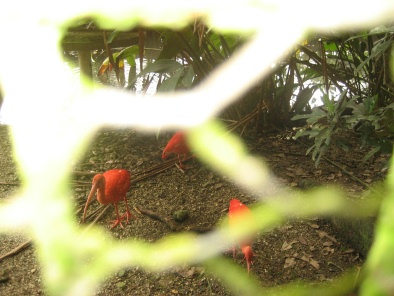
The red ibis is Trinidad's national bird and is scarlet red. There is another tour where you cruise along a river at the Caroni Swamp around dusk when the red ibis are returning to rest for the night. We haven't been on the tour but apparently the sky is red with the ibis as they flock in together and it is quite spectacular.
Unfortunately the fence didn't do justice to this photo.
Unfortunately the fence didn't do justice to this photo.
Croc Sighting
15 November 2007 | Point A Pierre
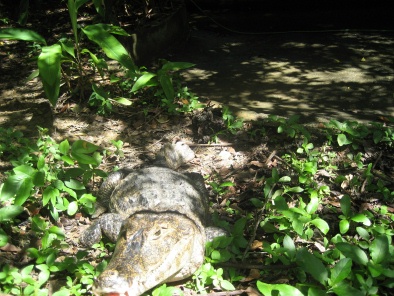
When they said "wildlife reserve" they really meant it. Although it doesn't show in this photo, this croc is behind a fence. He seemed quite interested in us as we walked past.
Peace and Tranquility
15 November 2007 | Point A Pierre, Trinidad
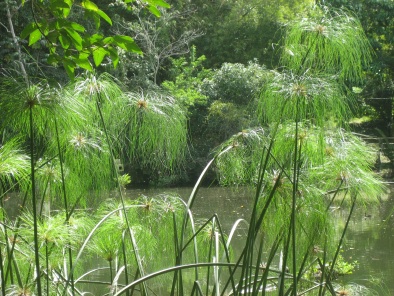
There was a large pond where birds were roosting and others fishing. We caught a glimpse of an osprey flying through which is quite unusual to see here. We also saw a nest with a couple of eggs in it that the staff were keeping an eye on.
Looking Through the Viewfinder
15 November 2007 | Point A Pierre, Trinidad

My greatest fear is my camera will quit functioning and I'll miss capturing some of these memories. The saltwater environment is so hard on everything and my camera does act up periodically telling me to change the battery when it has just been recharged. However, I pop it out for a second and push it back in and it usually goes again for awhile.
We protect our camera from saltwater by carrying it in a ziploc bag but there's only so much you can do.
We protect our camera from saltwater by carrying it in a ziploc bag but there's only so much you can do.
Views in the Gardens
15 November 2007 | Point a Pierre Wildlife Trust
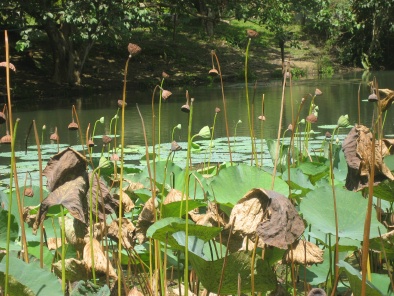
Enjoying the scenery...
Point a Pierre
15 November 2007 | Trinidad
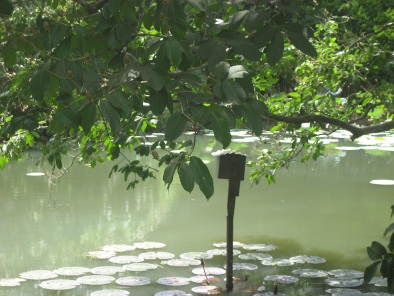
Leaving Pitch Lake we caught another maxi taxi to San Fernando. It was lunch time so we stopped at a roti shop and ordered their special, you guessed it, roti. Unfortunately it was mediocre at best but filled the hunger pangs and gave us energy for the next adventure planned that day. I seem to be the one who researches the sights in our guidebook and organize these outings. With one exception, they have worked out fine but I'm always a little concerned that the adventure might bomb. Fortunately I warn everybody in advance and let them know that things do not always turn out the way we expected.
So, since we were in the area, we decided to make a trip to another wildlife reserve which is a non-profit foundation, called Point a Pierre. It is on the edge of a large oil refinery so when you break into the pristine lushness of the wildlife reserve it is very refreshing.
According to our cruising guide, very few cruisers go to San Fernando and they are missing a treat. Again, we were met by a guide who walked us through the grounds imparting her knowledge. It was wonderful.
So, since we were in the area, we decided to make a trip to another wildlife reserve which is a non-profit foundation, called Point a Pierre. It is on the edge of a large oil refinery so when you break into the pristine lushness of the wildlife reserve it is very refreshing.
According to our cruising guide, very few cruisers go to San Fernando and they are missing a treat. Again, we were met by a guide who walked us through the grounds imparting her knowledge. It was wonderful.
Elephant Skin
15 November 2007 | Pitch Lake
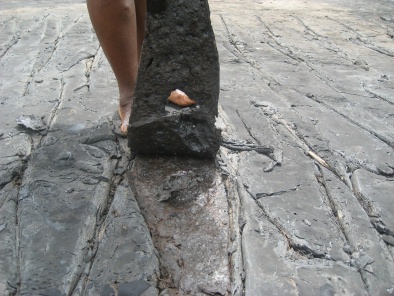
Even though it is mined, it continually regenerates itself so the supply is always available. Our guide pulled off the top layer that looks like elephant skin.
Our guide told us this was the 8th Wonder of the World.
Our guide told us this was the 8th Wonder of the World.
Digging It Up
15 November 2007 | Pitch Lake
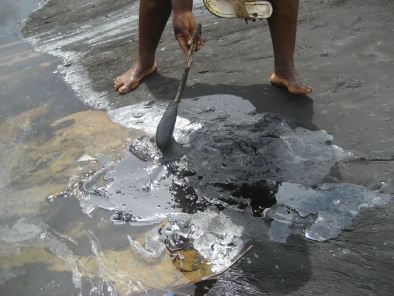
Using a stick, our guide could easily dig into the bitumen and draw up a long string of it. It almost looks like taffy.
Pitch Lake Leap
15 November 2007 | Trinidad
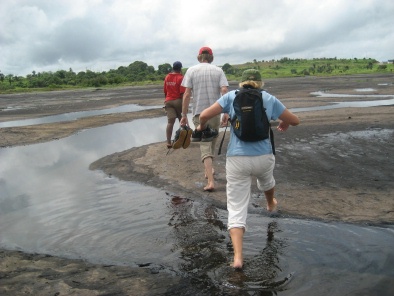
We removed our shoes and walked on the lake and it was extremely hot, almost burning our feet. There were areas where a crevace had formed and we had to jump over it. Other places we just enjoyed cooling our feet in the water where it wasn't too deep.
I thought this was a good photo of Kathy making a big leap.
I thought this was a good photo of Kathy making a big leap.
Pitch Lake
15 November 2007 | Trinidad
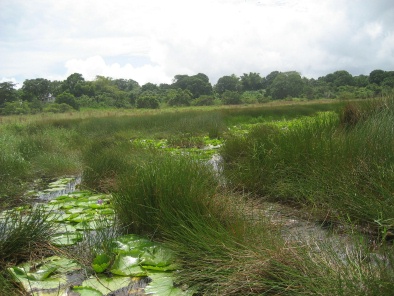
On another excursion 6 of us from TTSA caught an air-conditioned bus to San Fernando (about 1 1/2 hours from Port of Spain). The cost of the bus was about $5. From there we located the maxi taxis that go to Pitch Lake. Pitch Lake is a bitumen lake that is unique in the world. We met our guide at the gate, named Beverly, who took us on a tour.
Uninvited Guests
15 November 2007 | Asa Wright

These uninvited guests are scrounging for food dropped by the birds.
Powder Puff
15 November 2007 | Asa Wright
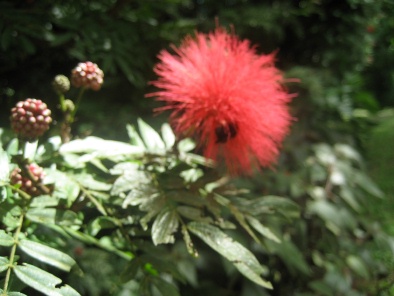
This tree is called Powder Puff. That's one I did remember.
More Bird Facts
15 November 2007 | Asa Wright, Trinidad
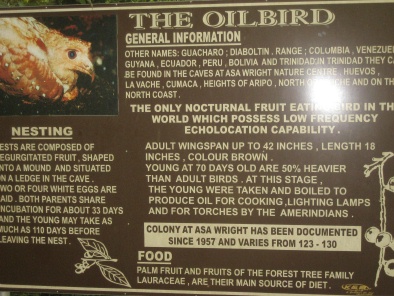
For those bird enthusiasts out there.
Asa Wright Center
15 November 2007 | Trinidad
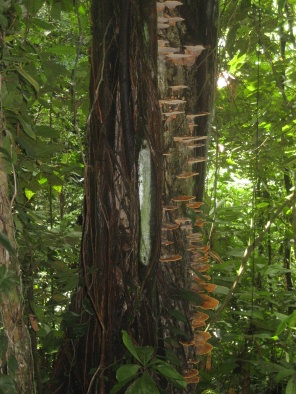
Unique trees at Asa Wright.
More Bird Feeders
15 November 2007 | Asa Wright, Trinidad
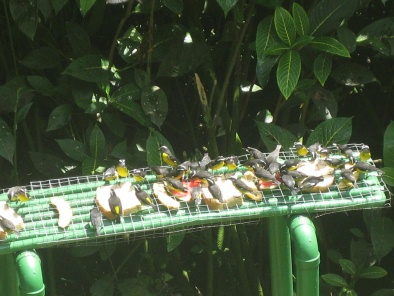
It's amazing to see the numerous varieties of birds at these feeders.
Asa Wright Vista
15 November 2007 | Asa Wright Nature Center, Trinidad
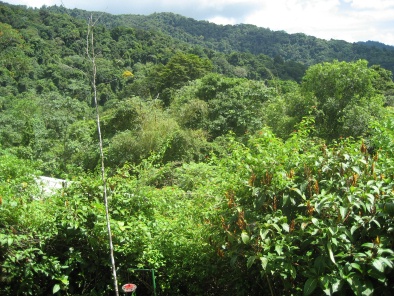
The property consisted of acres and acres of protected land. We learned that the driver we hired in Arima to take us to the center used to own some of the land and sold it to the government when the center changed hands.
Bird Feeders
15 November 2007 | Asa Wright, Trinidad

There were bird feeders all around the viewing veranda where guests could sit with a refreshment and watch the numerous varieties of birds come to the feeders. They refreshed them regularly to keep the birds coming. Many guests sat for hours with binoculars ready for a closeup view.
The bright blue bird with yellow legs and feet fascinated me. Anybody know what it's called?
The bright blue bird with yellow legs and feet fascinated me. Anybody know what it's called?
Endangered Birds
15 November 2007 | Asa Wright, Trinidad
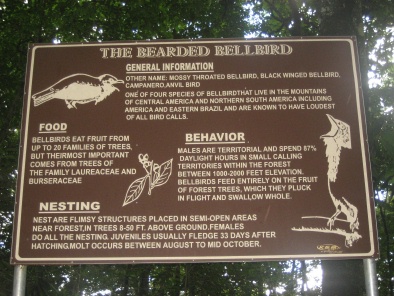
These posters are very interesting and make up for "senior moments".
Monkey Tree
15 November 2007 | Asa Wright Center, Trinidad
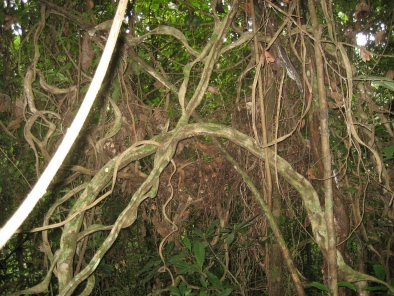
The property was full of interesting species of trees and vegetation. I think I'll remember what some of them were after the tour but the details quickly escape. Maybe it's more important to just enjoy the experience and forget about the details.
Following the tour we went back to the center where we had reserved for lunch. A smorgasbord was set up in a beautiful dining area with linen tableclothes and fine china. The food was excellent and included pumpkin soup, lamb, mixed vegetables and rice, to name a few, as well as dessert. The only thing missing was coffee at the end of the meal which is not a popular commodity on these islands. We drank in the lovely surroundings as we dined in elegance.
Following the tour we went back to the center where we had reserved for lunch. A smorgasbord was set up in a beautiful dining area with linen tableclothes and fine china. The food was excellent and included pumpkin soup, lamb, mixed vegetables and rice, to name a few, as well as dessert. The only thing missing was coffee at the end of the meal which is not a popular commodity on these islands. We drank in the lovely surroundings as we dined in elegance.
Ants
15 November 2007 | Asa Wright Nature Center, Trinidad
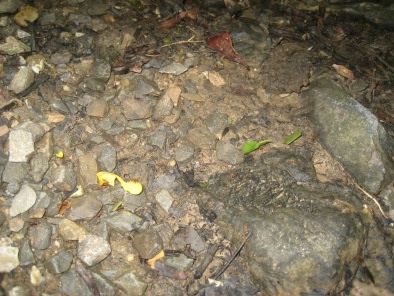
Look very closely and you will see a line of ants carrying leaves back to the colony. There were dozens of trails of ants on this property.
We visited the Asa Wright Nature Center by taking an air-conditioned bus from Port of Spain to Arima, then hiring a local car and driver to take us the rest of the way. We arranged for him to return in the afternoon to transport us back to Arima. Our guidebook misguided us, saying maxi taxis drove by the gate, but that was not so. We arrived just in time for the tour and joined a group of visitors to the island for about a one-hour tour. Interestingly a number of those on the tour were tour guides themselves, from Guyana. It is also a bird sanctuary for endangered species.
Asa Wright Center is one of the popular tourist attractions. It did not disappoint. There is overnight accommodation for those who are looking for a peaceful, beautiful escape from the ratrace. The property used to be owned by Asa Wright but was turned over to the government after she passed away.
We visited the Asa Wright Nature Center by taking an air-conditioned bus from Port of Spain to Arima, then hiring a local car and driver to take us the rest of the way. We arranged for him to return in the afternoon to transport us back to Arima. Our guidebook misguided us, saying maxi taxis drove by the gate, but that was not so. We arrived just in time for the tour and joined a group of visitors to the island for about a one-hour tour. Interestingly a number of those on the tour were tour guides themselves, from Guyana. It is also a bird sanctuary for endangered species.
Asa Wright Center is one of the popular tourist attractions. It did not disappoint. There is overnight accommodation for those who are looking for a peaceful, beautiful escape from the ratrace. The property used to be owned by Asa Wright but was turned over to the government after she passed away.
Coconut Water
13 November 2007 | Port of Spain
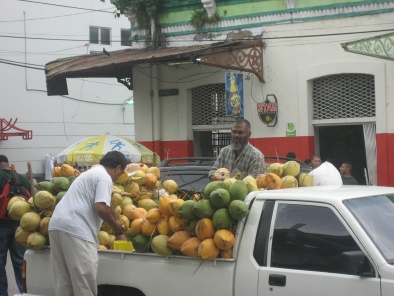
A vendor is selling coconut water which is a popular, thirst-quenching drink in the islands.
Independence Promenade
13 November 2007 | Port of Spain
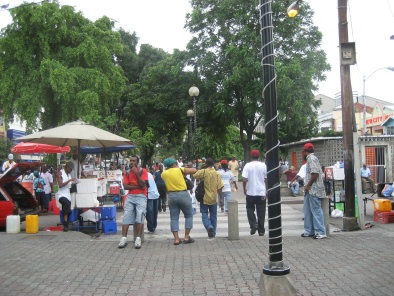
There are lovely parks scattered throughout the city as well as this long promenade that runs for several blocks. There are benches where people just sit and enjoy people watching, eat lunch or visit with their friends. Around 5 p.m. it comes alive with vendors selling Double Doubles which are delicious. They are like a pancake filled with mashed chick peas, potato and curry sauce. They are about 50 cents each and can be ordered with hot sauce or without.
Forgot Our Bathing Suits
13 November 2007 | Macaripe Bay, Trinidad
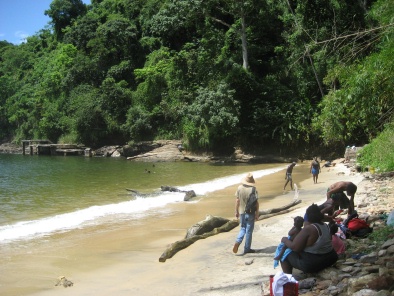
Darn, we forgot our bathing suits. Watching the locals enjoying this beautiful, clean water and not being able to join them was disappointing. We'll have to remember to pack our suits regardless.
We waded in the water and sat in the shade enjoying the peaceful setting. We were surprised at the number of young people there on a weekday.
Getting back to the anchorage proved to be a challenge. It was so hot and we were already exhausted but off we went, walking along the paved road. We had hoped somebody would stop and offer us a ride but there were four of us and there weren't many empty cars driving by. After walking about 30 minutes in the heat, a Chagaramus National Park truck stopped and offered to transport us in the back to the main road. It is illegal to carry passengers in the back of a truck so they weren't prepared to take us further, but it was a welcome relief to get to the main road.
Once we were dropped off we treated ourselves to lunch at KFC. Speaking of KFC, there seem to be more KFC's per capita in the islands than anywhere we've ever been. We walked from KFC back to the anchorage and were happy to arrive at our dinghy. It had been quite a day.
We waded in the water and sat in the shade enjoying the peaceful setting. We were surprised at the number of young people there on a weekday.
Getting back to the anchorage proved to be a challenge. It was so hot and we were already exhausted but off we went, walking along the paved road. We had hoped somebody would stop and offer us a ride but there were four of us and there weren't many empty cars driving by. After walking about 30 minutes in the heat, a Chagaramus National Park truck stopped and offered to transport us in the back to the main road. It is illegal to carry passengers in the back of a truck so they weren't prepared to take us further, but it was a welcome relief to get to the main road.
Once we were dropped off we treated ourselves to lunch at KFC. Speaking of KFC, there seem to be more KFC's per capita in the islands than anywhere we've ever been. We walked from KFC back to the anchorage and were happy to arrive at our dinghy. It had been quite a day.
Macaripe Bay
13 November 2007 | Trinidad

We walked along the crest of the mountain enjoying the views. Then there was a long downhill portion to the beach but better than uphill. We were quite tired by now but enjoyed the invigorating hike.
Beautiful Sight
13 November 2007 | Macaripe Bay, Trinidad
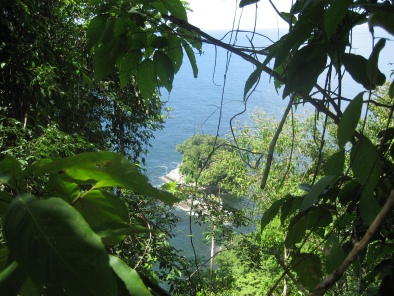
After a long uphill climb the vista is breathtaking. Macaripe Bay is a peaceful beach that mostly locals enjoy. We were about to discover why it is just frequented by locals. There is no public transportation from there and we hadn't arranged for a ride back.
Macaripe Bay Hike
13 November 2007 | Trinidad
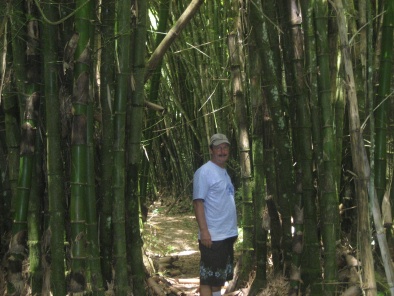
We have discovered that we are quite the adventurers compared to a lot of other cruisers and don't hesitate to join the locals in travelling to and visiting their communities. We find this is much more interesting than exploring with other boaters in organized tours.
If you are quiet and patient the jungle will offer amazing sights and sounds. If not, you'll likely miss them. This is Bill walking through a grove of bamboo.
If you are quiet and patient the jungle will offer amazing sights and sounds. If not, you'll likely miss them. This is Bill walking through a grove of bamboo.
| Vessel Make/Model: | Tayana Vancouver 42 |
| Hailing Port: | Vancouver, Canada |
| Crew: | Bill & Bev Bate |
| Extra: | Our mission is to participate in the development and spread of goodwill between countries and peoples through Schools Beyond Borders Foundation. |
Gallery not available
El Shaddai
Who: Bill & Bev Bate
Port: Vancouver, Canada
Favorites
- Venezuela Cubagua
- Venezuela Margarita
- Venezuela Los Testigos
- Tobago
- Trinidad Turtles
- Macareo River, Venezuela
- Vancouver, B.C. Canada
- Kelowna, B.C. Canada
- Trinidad Carnival
- Trinidad Gabriella
- Manamo River, Venezuela
- Grenada
- Grenadines
- Canouan
- St. Vincent
- Martinique
- St. Lucia
- Dominica
- Guadeloupe
- Montserrat
- St. Kitts
- Nevis
- St. Barts
- Sint Maarten/St. Martin
- Dominican Republic
- Haiti
- Cuba
- Jamaica
- Haul Out Navimca, Venezuela
- Trinidad
- Venezuela
- Junkanoo
- Missions' Teams Projects
- Bahamas Photos
- El Shaddai
- Show All Posts